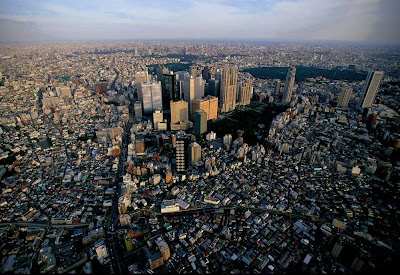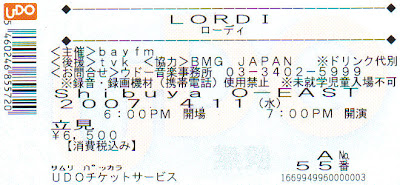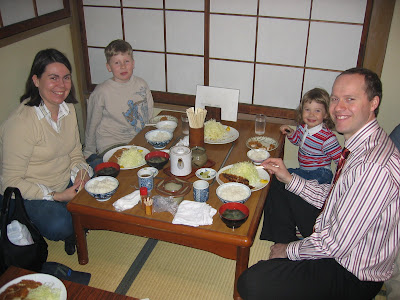Sunday, April 29, 2007
Monday, April 23, 2007
Culture shocks


2004年3月に初めて東京を訪れた時のことを今でも私は覚えています。あるプロジェクトに関わってヴァイサラ本社からヴァイサラ東京オフィスを訪れた時のことです。日曜日の夜遅くに成田エクスプレスで東京に着いたのですが、近づくにつれ、ビルとネオンの数に驚きました。初めは東京の大きさと人口に驚きました。日本と同じ大きさであるのに人口わずか5百万人であるフィンランドの出身の私には、東京は落ち着かない、人を引きつけない大都市のように思えました。しかしすぐにそうではないと発見したのです。
翌日から数日間、私は神楽坂にある弊社のオフィスで働き、とても伝統的、日本的な環境を経験しました。人々は急いでいるように見えても急いでいるのではない−単に人が沢山いるだけで実際には誰も急いではいない、と気付きました。また、大都市にいることを忘れられる静かな避難所のようなところがあることにも気付きました。ある朝散歩をしていて、オフィスの近くの神社にたどり着きました。そこに立ち止まったわずかの間、ラッシュアワーと人混み、辺りのひしめき合ったビルを完全に忘れてしまったのです。同じことが飲食店にいる時にも起こりました。外のめまぐるしい通りを忘れ、突然別世界にいるような気持ちになることが。初めて起こったのは神楽坂通りの回転寿し屋と豚カツ屋にいた時でした。今でも毎週同じ寿司屋にランチに行くと、時が止まり、そしてお気に入りの寿司を食べ、くつろぎます。東京でとても好きになったのは小さい隠れた場所のこの安らぎです。
挑戦してみることに決めました。それは大きな決断でした。妻が言った最初の言葉は「どこか英語圏の国での仕事はないの?」でした。この言葉から、私たちが直面したカルチャーショックをだいたい理解して頂けると思います。
2005年8月、私は妻のリ-ッカ、息子のオスカリ(当時8歳)、娘のアウラ(当時3歳)と共に一家で東京へ移住しました。いくつかカルチャーショックを経験しましたが、後に違いを尊重することを学びました。
1つ目のショックはやはり東京の人とビルの多さでした。私たちはフィンランドの首都のヘルシンキから移って来ました。ヘルシンキと周辺の都市を合わせたサイズは東京と周辺の都市を合わせたサイズとほぼ同じです。ところがヘルシンキ首都圏にはわずか100万人強の人々が住み、一方東京首都圏には3000万人強もの人々が住んでいます。これは私たちが毎日どこへ行っても気が付くことです。私たちは初め、家々には庭があり、店には十分な駐車場があり、道は広いなど、フィンランドの見慣れた風景がないことがショックでした。しかし今では、フィンランドに行くと店が9時に閉まり、日曜日は閉店、外食は高い、家に物を簡単には配達してもらえない、おつりを返すときに誰もお辞儀をしないなどということにショックを受けます。
2つ目のショックは気候でした。私たちは8月に移ってきましたが、極度に暑く湿気がありました。子供たちは昼間公園で遊ぶことはできず、近所の子供会館は外よりも更に暑かったのです。すぐに台風の季節が到来し、風が窓ガラスを破って吹き込んでくるのではないかと恐ろしかったです。そしてもちろん地震もいくつか経験しました。日本の地震がフィンランドのニュースで言及されるたびに、私の母と妻の母は心配します。「お母さん、仙台は東京にあまり近くないんだよ。それにもし1億3000万人の人が日本に住めるなら私たちだって大丈夫」。台風の季節は終わり、フィンランドでは冬がもう近づいているというのに、暖かい秋の日々は永遠に続く夏のように感じられました。沖縄では11月でも夏の気分を味わうことができ、1月の長野県では冬を見つけることができました。初めはとてもショックだった気候も実は故郷のフィンランドよりもずっと快適でした。もちろん故郷の冬の純白の雪や暖かい夏の日々を恋しく思いますが、そういった景色は実際よりもポストカードでよく見られるものです−ちょうど東京から毎週のようには富士山がくっきりと見えないのと同じように。
3つ目のショックは妻の言葉が既にほのめかしたことー日本語です。3種類もある日本語の表記−ひらがな、カタカナ、漢字。私たちは一から始めなければなりませんでした。これは容易なことではありません。ひらがなの“そ”と“る”と“ろ”の違いを一体どうしたら覚えることができるのでしょうか?または“ね”“れ”“わ”の違いは?それにひらがなの“ふ”とカタカナの“ホ”も私には全く同じに見えるのです。そして漢字は中国語だとずっと思っていたのですが、ここでも使われているとは。そしてどこで一つの単語が終わり、どこから次の単語が始まるのかー単語と単語の間にスペースはないの?ヘルプ!しかし私が知っているヨーローッパのどの言語も助けにならないのでした。ある朝オフィスに向かっているとき、初めての漢字を覚えました。とても多くの地下鉄の駅で書かれているその奇妙な形は何か意味があるにちがいない。飯田橋、日本橋、新橋、水道橋。−やはり意味があった。“ブリッジ”という意味だ。次に覚えた漢字はもっと容易で分かりやすいもので、単純な“タ/ダ”です。飯田橋、三田など。稲田という意味だ。なんだ、日本語を覚えるのは楽しいじゃないか!
サムリ
I still remember the first time I visited Tokyo in March 2004. I was visiting Vaisala Tokyo office on a project from the head office. I arrived late Sunday night by Narita Express to Tokyo and was astonished by the number of buildings and neon lights when approaching. I was at first shocked by the size of Tokyo and the amount of people here. Coming from Finland, a country of same size as Japan, but with only 5 million people, Tokyo seemed to be a restless uninviting metropolis. But soon I discovered it was not.
During the following days I worked at our office in Kagurazaka and experienced quite traditional Japanese surroundings. I realized that even though people seemed to be in hurry, they were not - there were just so many people, but nobody was actually in a hurry. I also realized that there were quiet havens where one could forget being in a huge city. One morning I was wandering around and came to a shrine close to our office. When I stopped there for a moment, I completely forgot the rush hour, people and buildings nearby. The Same thing happened in restaurants, where I suddenly had the feeling of being like in a different world, forgetting the hectic street outside. This first happened at a kaiten sushi and at a tonkatsu shop on Kagurazaka dori. Even now when I go to the same sushiya for lunch every week, time stops, and I eat my favourite sushi and relax. It was this peacefulness in small hide-away-places that I fell in love with in Tokyo.
Some time after my first visit I learned that there would be a job opening in the Tokyo office. I was so impressed by my visit that I decided to go for it. It was a big decision. My wife's first comment was "Don't they have anything available in any English speaking country?". And that gives a rough understanding of the culture shock we were to face.
In August 2005 I moved to Tokyo with my family, my wife Riikka, our son Oskari (8 years old at that time), and our daughter Aura (3 years old at that time). We have experienced several cultural shocks, but after them we have learned to respect the differences.
The first shock was again the amount of people and buildings in Tokyo. We moved from Helsinki, the capital of Finland. Helsinki and its surrounding cities are roughly the same size as Tokyo and its surrounding cities. But only a bit over 1 million people live in greater Helsinki, whereas a bit over 30 million people live in greater Tokyo. This is something that we notice everywhere, every day. We were first shocked about the things we missed from Finland, where houses have yards, shops have ample parking places, roads are wide etc. But now we are shocked when we go to Finland, where shops close at 9 pm and are closed on Sundays, eating out is expensive, you can't easily get things delivered to your home and nobody will bow when giving you your change money back etc.
Our second shock was the weather. We arrived in August and it was extremely hot and humid. Our children could not play in the park during daytime, and the nearby children's hall was even hotter than outside. Soon came the typhoon season, and we feared that the wind would blow our windows in. And of course we experienced several earthquakes. Every time a Japanese earthquake was mentioned in the Finnish news our mothers got worried: "Mom, actually Sendai is not very close to Tokyo. If 130 million people can live in Japan, why can’t we?" Typhoon season ended, and warm autumn days felt like everlasting summer while winter was already coming to Finland. And I was able to feel like summer in Okinawa in November, and we found winter in Nagano-ken in January. The first so shocking weather was actually much more pleasant than what we have back home in Finland. Of course we miss the pure white snow during winter or nice warm summer days back home. But they are found more often in post cards than in real life - just like you don't have a clear view of Mt Fuji from Tokyo every week.
The third shock was the one my wife's comment already hinted at - Japanese language. We had to start from the beginning - the Japanese alphabet, or actually the three of them: hiragana, katakana and kanji. That is not an easy task. How could I ever learn the difference between hiragana of “so”, “ru” and “ro”? Or “ne”, “re” and “wa”? And to me hiragana “fu” and katagana “ho” look just the same. And I always thought kanji is Chinese, is it used also here? And where does one word end and another one start – there are no spaces between words? Help! But I could not get any help from any European language I knew. Then one morning going to the office I learned my first kanji- that strange thing written in so many metro stations must have some meaning Iidabashi, Nihonbashi, Shimbashi, Suidobashi, ... And it had - it means "bridge". My next kanji was easier and more obvious, the simple “ta”/”da” Iidabashi, Mita, …, meaning rice field. Hey, learning Japanese was fun after all!
Samuli
Lähettänyt
ROSA
klo
10:58 AM
0
kommenttia
![]()
Labels English summary, Japani on erilainen, 日本語
Friday, April 13, 2007
Lordin konsertissa

 Kävimme keskiviikkona Lordin konsertissa. Keikalle pääsivät Samuli, Oskari, Riikka ja Oskarin luokkakaveri Olivia, joka on kova Lordi-fani.
Kävimme keskiviikkona Lordin konsertissa. Keikalle pääsivät Samuli, Oskari, Riikka ja Oskarin luokkakaveri Olivia, joka on kova Lordi-fani.
Keikka oli aika raju, ja näimme bändin melkein eturivistä!
Tupa oli täynnä, japanilaiset heiluivat musiikin tahdissa ja huitoivat Lordin käsimerkkejä ilmaan. Joku osasi jopa biisien sanoja! Keikka kesti noin 1,5 tuntia ja loppui ihan sopivasti klo 20.30, joten saimme nuorison kotiin ajoissa, heräämään seuraavana aamuna kouluun.
Yritimme myös päästä nimmareiden toivossa kurkistamaan backstagelle, mutta japanilainen turvamies oli tosi tiukkis eikä päästänyt meitä lähellekään. Neuvottelemaan emme ryhtyneet, sillä vartijan englanninkielentaito tuntui koostuvan vain seuraavasta fraasista: " No, go, please!"
Oskari sai kuitenkin tuliaisiksi t-paidan, avaimenperän ja vanhimman Lordi-levyn ja Oliviakin onnistui nappaamaan avaimenperänsä kaveriksi basistin heittämän plektran, joten emme olleet kovin pahoillamme. Ja onneksi ostamamme cd:n mukana tuli hieno nimmarikortti, joten sekin puoli hoitui, sittenkin. Tosin itse pyydetty nimmari on aina parempi kuin pussillinen saatuja...
R.O.S.O.
Katso kaikki Lordi-jutut blogistamme
Lähettänyt
ROSA
klo
9:57 PM
3
kommenttia
![]()
Labels Erikoisia tilanteita, Lasten Japani
Saturday, April 07, 2007
Monday, April 02, 2007
Hanami

ROSA
(from Daily Yomiuri / Los Angeles Times)
Early again. As usual.
The beginning of sakura has been creeping up on the Japanese in recent years. This year's start was eight days earlier than the average in Tokyo over the last half a century, part of a pattern that many scientists here attribute to global warming.
For well over a millennium, the Japanese have made a sport of their collective anticipation of the annual explosion of pink and white sakura blossoms that marks the arrival of spring. The moment is more spiritual than botanical. The cherry blossom is a symbol of Japanese identity. The petal's 10-day span from glorious youth to wilting and inevitable death is seen as a metaphor for life's swift passage.
It is also an excuse for executives, students and stay-at-home moms to ditch work and throw daylong parties of singing and drinking under canopies of petals.
The sakura once bloomed in a monthlong wave that spread northward, culminating on the chilly island of Hokkaido. Their progress was tracked, informally for centuries — and since 1953 by the scientists at the Japan Meteorological Agency — with a care and concern normally reserved for the movement of typhoons.
But the official advent of sakura has moved up by 4.2 days since records started to be collected, Japan's Environmental Agency says. And the blossoms are coming out even earlier in the big cities, regardless of latitude: 6.1 days earlier in the six largest urban areas, according to the agency's data.
Tokyo saw the nation's first blossoms this year — at least as officially noted by the inspectors. The city of Fukuoka followed a day later, earlier than rural parts of the southern island of Kyushu.
Scientists say that's because the concentration of high-carbon fuel use in big cities makes urban temperatures higher than in the countryside.
Lähettänyt
ROSA
klo
8:48 PM
2
kommenttia
![]()














